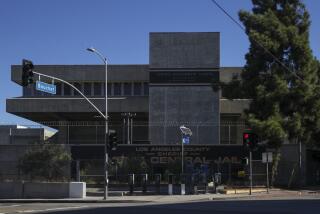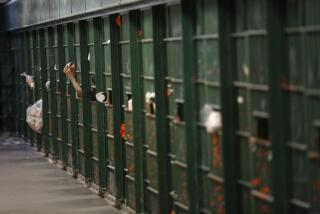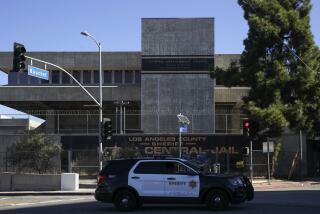Prison design faces judgment
It might be the most carefully hidden building boom in American architectural history.
Over the last 40 years, beginning with strict drug-sentencing laws introduced in 1973 by New York Gov. Nelson Rockefeller and quickly copied around the country, the number of prisons in this country has more than tripled, from 600 to nearly 2,000.
In California, where the inmate population surged a staggering tenfold from 1975 to 2010, the construction of jails and prisons has accelerated even more quickly.
Yet the buildings themselves have managed to stay shrouded. New prisons are often stashed in rural areas or in the lonelier corners of American downtowns, where in some cases they fill districts vacated in the postwar decades by residents and corporations decamping for the suburbs.
PHOTOS: Arts and culture in pictures by The Times
And just as prisons in the U.S. are now designed to look not just secure and largely windowless but so nondescript that they practically disappear, architecture firms often coat their prison-design work in several layers of euphemism.
Prisons and jails become “correctional facilities.” On the website of the large corporate firm HOK Architects, which designed the 1997 Twin Towers Correctional Facility in downtown L.A., they are tucked into a broader portfolio of “justice buildings.”
But thanks to a growing number of factors — some within the architecture profession, some political, others in pop culture — prison design is shedding some of that carefully managed anonymity.
An architect in San Francisco, Raphael Sperry, is calling on members of the profession to reject prison commissions on ethical grounds, especially the design of cells meant for solitary confinement or execution. “Corrections & Collections: Architectures for Art and Crime,” a fascinating new book by Joe Day, an L.A. architect who teaches at the Southern California Institute of Architecture, charts not just the history of jails but the surprisingly broad — and telling — overlap between prison and museum design.
RELATED: A tour of Los Angeles’ boulevards
An exhibition organized by UC Riverside called “Geographies of Detention,” running through Sept. 7, is relentless in its effort to force viewers to confront the products of what its curators, Catherine Gudis and Molly McGarry, call California’s “prison-industrial complex.”
Even as television series like Netflix’s popular “Orange Is the New Black” bring scenes of prison life to our TVs and iPads, debates over the future of Guantanamo Bay and overcrowded California prisons have exposed the facilities — and the details of their architecture — to new scrutiny.
There is even a new video game from the British developer Introversion Software called “Prison Architect” that allows users to design and run prisons the way users of the popular game SimCity design and run cities.
As if to acknowledge that the great prison expansion no longer deserves automatic or unqualified support from the federal government, U.S. Atty. Gen. Eric H. Holder Jr. argued in a high-profile speech last month that the Rockefeller drug laws have essentially failed.
“Widespread incarceration at the federal, state and local levels is both ineffective and unsustainable,” said Holder, calling the American prison population “unnecessarily large.”
For all the media coverage it generated, the immediate practical effect of Holder’s speech is likely to be modest. The federal policy change it trumpeted, calling on prosecutors not to invoke minimum-sentence guidelines for minor drug offenses, won’t do a thing to shrink prison terms at the state or local level. Federal prisons hold just 14% of American inmates.
And yet the speech reflects a marked new interest in American society in reexamining our national experiment, now nearing four decades in length, in hyper-aggressive incarceration.
We shouldn’t overlook the role of pop culture in this shift. Sympathetic characters in the theater, in movies and on television often either foreshadow or pave the way for changes at the level of policy and law.
In “Oz,” which ran on HBO from 1997 to 2003, inmates were threatening and aggressive — the show made us glad they were locked up. “The Wire,” from 2002 to 2008, represented a middle ground: Some of its drug dealers were violent and incorrigible, but others were entirely sympathetic, and the show offered a sharp and sustained critique of strict Rockefeller sentencing and the war on drugs.
“Orange Is the New Black” represents the far end of this spectrum, an unapologetic attempt to humanize the prison population, replacing scowls with complex and often mitigating back stories. Most of its female inmates are about as far from menacing as you can imagine in a show set in federal prison.
A byproduct of these series — along with prison-based reality shows on the Discovery and National Geographic channels — has been to give Americans a newly wide and sometimes alarming window into how prisons are designed. Some viewers may notice what Day emphasizes in “Corrections & Collections”: that the design of many modern prisons and contemporary museums, marked by a sort of concrete asceticism, flows from the same post-minimalist wellspring.
“A newly simplified architectural vocabulary,” Day argues, now marks these “institutions of constraint and display.” In his introduction to the book, the writer Mike Davis calls the “co-evolution of prisons and museums” over the last three decades a “conflation of collection and punishment.”
Davis adds, “Day’s thesis, refined to a single sentence, is that the warehousing of surplus people and over-valued objects on an unprecedented scale is the expression of a single social logic.”
It may sound like a stretch, but Day makes a strong case. In its early chapters, the book often puts a photograph of a prison on one side of a spread and a museum on the other; it’s often nearly impossible to tell which is which.
Is that Tadao Ando’s 1992 museum in Kumamoto, Japan? Or is it the Coyote Ridge Corrections Center in Washington state, completed in 2008? Is that Gordon Bunshaft’s Hirshhorn Museum in Washington — a building, not incidentally, that Ada Louise Huxtable condemned in 1974 as an example of “neo-penitentiary modernism” — or Cuba’s Presidio Modelo?
Inside these buildings, the similarities continue. The art world’s prototypical “white cube” gallery space is based on essentially the same design preferences — strict minimalism, fanatical control of sightlines and lighting — as the contemporary prison cell.
The new batch of lockup shows has also raised public awareness about twin crises in U.S. prisons: overcrowding, which has been at epidemic levels for more than a decade, and the manner in which many American prisons treat inmates in solitary confinement.
American prisons have usually included some separate rooms or wings for prisoners kept apart from the rest of the population. Thomas Jefferson, in his preliminary design for a jail in Nelson County, Via., that was built in 1823, included a small windowless room that he labeled “solitary cell.”
Over time these solitary cells have grown sparer in their design and, as part of a more powerful penal system, more crushing in their effect on human psyches. It was the Pelican Bay state prison in Crescent City, Calif., completed in 1989 and designed by the San Francisco firm KMD Architects, that began to draw wide attention to the harshness of much contemporary solitary confinement. (KMD did not respond to a request for comment on this story.)
Pelican Bay’s Secure Housing Unit, or SHU, helped usher in a new design approach in which violent inmates are separated not only from one another but largely from prison staffs as well. In a digital-age update of the panopticon-style prison in the round first designed by the British philosopher and economist Jeremy Bentham in the 18th century, the small cells in the Pelican Bay SHU are largely monitored remotely, by guards watching video feeds of inmates in their cells.
To give the guards a crisp view of those cells at all times, the lights are never switched off. Inmates are allowed to leave only for exercise — which takes place in open-air windowless pens with concrete walls 20 feet high — and showers. Typically, they spend more than 23 hours every day in their cells. Across the state prison system, SHU inmates are 33 times more likely to commit suicide than other inmates.
Sperry, leading the prison-design boycott movement, has described long-term solitary confinement as torture. He has called on the American Institute of Architects to amend its code of ethics and professional conduct to ban members from designing them (or rooms where death-row inmates are executed).
But the moral questions here get tricky pretty quickly. The SHU at Pelican Bay is actually marginally better designed than solitary units at other prisons, in part because of details that the KMD architects insisted on, including a system to bring natural light through perforated doors into each cell.
In a broader sense, the kinds of architects who would sign a ban are also the ones who are most likely, if they were to design a prison, to fully consider the psychological health of inmates. Instead of parsing the details of a massively complex moral quandary, perhaps the goal should be simpler: to aim for a society that produces both better-designed prisons and fewer ones.
This is a debate, in other words, that needs to proceed on dual tracks, one about policy — about whether the Rockefeller laws have run their course, and if so how they ought to be most swiftly and intelligently reformed — and the other about architecture.
Still, as we begin to look more closely at the design of the prisons we plan to build and those we already have, we may realize that our binge of construction has affected not just how we house prisoners but how we shape and plan our cities — and in particular our downtowns.
Many large prisons, Pelican Bay among them, were built as far from metropolitan regions as possible. The large landscape paintings by Sandow Birk that make up the heart of the “Geographies of Detention” exhibition suggest the way so many California prisons are estranged from urban life and make up a new category of rural architecture in the state.
But as Day points out, we’ve also shoehorned many prisons and jails into overlooked corners of American downtowns, often adjacent to or literally connected to courthouses (and not far from new downtown museums). This has certainly been the case in Los Angeles, where HOK’s Twin Towers complex, a county facility, went up 15 years ago on a site between Union Station and the L.A. River.
Now, as Los Angeles looks to remake both the station and the river — just as cities around the country are reimagining their waterfronts and downtowns — we find the location of that jail, and others downtown, is poised to become a major civic headache, if not an outright embarrassment. No one wants to spend millions of dollars remaking the section of the L.A. River running through downtown only to realize that one of the buildings most clearly visible from the newly green banks is a huge and infamous county jail.
We may have done our best as a society to camouflage the rush of construction that produced so many new prisons over the last 40 years. But that doesn’t make the prisons themselves, once we do starting turning our attention to them, any less real or immovable.
christopher.hawthorne@latimes.com
More to Read
The biggest entertainment stories
Get our big stories about Hollywood, film, television, music, arts, culture and more right in your inbox as soon as they publish.
You may occasionally receive promotional content from the Los Angeles Times.































































































































